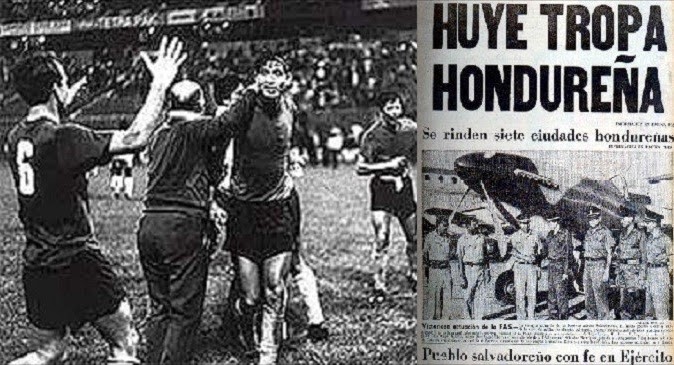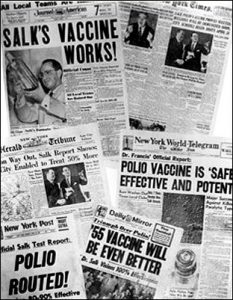
The 1969 play-off match between El Salvador and Honduras (two teams that are not only neighbors but rivals) was filled with anticipation and aggression. This playoff match would decide which nation would be attending the world cup, and which would be staying home. El Salvador and Honduras had each won one match which forced a third, and final, play-off match.1 In the prior matches, fights had broken out between fans in the street and in the stands during the game. But on the day of the final play-off, a much more significant event would take place. The game was scheduled in Mexico City: a third-party country with no bias toward either team. The day of the playoff, El Salvador dissolved all diplomatic ties with Honduras right before the match.
In the first game between the two nations, Honduras won the match 1-0 in its own capital. Some Hondurans stayed outside of the hotel that the El Salvador team had been staying at and threw rocks, set off car alarms and threw firecrackers.2 The 2nd match took place in San Salvador, where the home fans would watch their team win by a commanding score of 3-0. Before the 2nd match took place, the Honduran National team had a security force with them at all times. During the game the security at the stadium was extremely tight with lots of alcohol and weapons confiscated as a security precaution. As the Honduran national anthem played, the home team and fans were extremely disrespectful towards the players and their country. This caused some whiplash for El Salvadorians living in Honduras as their businesses were boycotted and vandalized.3 Leading up to the series of matches, the two nations were in a deep dispute over land reform and immigration. El Salvador was sending its poorest citizens into Honduras so the wealthy could maintain their land.4 El Salvador had a much bigger population than Honduras. Honduras had a population of about 2 million, where as El Salvador had a population of almost 4 million.5

However, they had a significantly smaller amount of land which forced more than 275,000 El Salvadorians to flee into Honduras, causing poverty and crime.6 Honduras accused the El Salvadorians of stealing jobs from the native people of Honduras. But after the 2nd games violence, El Salvador accused Honduras of staying silent while El Salvadorians living in Honduras were raped, murdered, robbed, and oppressed. Neither side was willing to negotiate to the smallest extent, which led to tensions building up even more. In the final match between the two teams, El Salvador won the game in overtime with the score of three to two.7 This caused numerous Salvadorians to be killed in Honduras.8
On July 14th, 1969, almost 3 weeks after the final playoff game, El Salvador bombed targets inside of Honduras. They crippled Honduras by attacking their main airport which left them unable to react to the attack at optimal speed.9 El Salvador then attacked from the ground by marching through the two main roads that connect the countries. Only one day later, the El Salvadorian army had pushed Honduras back over 8 kilometers. The El Salvadorian Army continued to make steady progress. They were nearing the capital city of Honduras, Tegucigalpa, when Honduras finally pushed back. The Honduran Air Force attacked Llopango base. The bombers eventually progressed to Acajutla port, which was important because it was home to El Salvadorian oil refineries. Later that evening huge smoke clouds covered the coast as the the oil refineries were bombed.10
Fearing that the nearing El Salvadorian army would overtake the capital, Honduras called the Organization of American States for help. The Organization of American States (OAS) had an urgent meeting on the evening of July 15th and called for El Salvador to withdraw its troops from Honduras ensuring that its people living in Honduras would not be harmed.11 El Salvador refused, demanding reparations be paid to them and their citizens. El Salvador attempted to further the attack the capital city, but they were unable to proceed with the attack. The previous strike on their oil refineries had destroyed their line of fuels and supplies and they no longer had supplies arriving every other day. Somoza Debayle, the dictator of Nicaragua was also helping Hondurans by arming them with weapons and providing ammunition. The OAS worked night and day in order to provide a cease-fire that would please both parties. Finally, on the night of July 18th, a ceasefire was arranged and became effective two days later.12
Although the cease-fire had been called, El Salvador refused to leave Honduras. They stayed until they were threatened by the OAS with economic sanctions against them. The El Salvador government finally withdrew troops on August 2, 1969. The aftermath of the 100-hour war was anything but slim. More than 2000 civilians were killed, with more than 100,000 immigrants displaced.13 Although they were no longer at war with each other, these two nations peace treaty only came into force on December 10, 1980.14
- Paul Joseph, The SAGE Encyclopedia of War: Social Science Perspectives, 2017 s.v . “Soccer War.” ↵
- Hatcher Graham, Salem Press Encyclopedia, 2013, s.v “Soccer War.” ↵
- Steve C. Ropp, 1982, “The War of the Dispossessed: Honduras and El Salvador, 1969. Thomas P. Anderson.” The Hispanic American Historical Review, no. 2: 296. JSTOR Journals, EBSCOhost (accessed February 5, 2018). ↵
- Richter, Ernesto, John Beverly, Bob Dash, and Irma Fernandez Dash. “Social Classes, Accumulation, and the Crisis of “Overpopulation” in El Salvador” Latin American Perspectives, 7, 1980 ↵
- Ernesto Richter, John Beverly, Bob Dash, and Irma Fernandez Dash. “Social Classes, Accumulation, and the Crisis of “Overpopulation” in El Salvador”, Latin American Perspectives, 7, 1980. ↵
- Charles Clements, Witness to War: an American Doctor in El Salvador (New York; Bantam Book, 1984). ↵
- Hatcher Graham, Salem Press Encyclopedia, 2013, s.v “Soccer War.” ↵
- Charles Clements, Witness to War: an American Doctor in El Salvador (New York; Bantam Book, 1984). ↵
- Charles Clements, Witness to War: an American Doctor in El Salvador (New York; Bantam Book, 1984). ↵
- Charles Clements, Witness to War: an American Doctor in El Salvador (New York; Bantam Book, 1984). ↵
- Charles Clements, Witness to War: an American Doctor in El Salvador (New York; Bantam Book, 1984). ↵
- Charles Clements, Witness to War: an American Doctor in El Salvador (New York; Bantam Book, 1984). ↵
- Charles, Clements, Witness to War: an American Doctor in El Salvador (New York; Bantam Book, 1984). ↵
- Charles Clements, Witness to War: an American Doctor in El Salvador (New York; Bantam Book, 1984); and United Nations -Treaties Series, General Peace Treaty Between the Republics of El Salvador and Honduras, 1980, https://peacemaker.un.org/sites/peacemaker.un.org/files/HN-SV_801030_GeneralTreatyOfPeaceElSalvadorHonduras.pdf. ↵



106 comments
Roman Olivera
Its sad to see two countries that had way bigger issues than futbol, turn to such violence after something that is supposed to bring unity to people around the world and show pride for ones country. This puts both government and the people of these countries in a bad light and does not give them anything to be proud over. The turmoil in these countries goes even farther back then these soccer or futbol games and these countries have also had great conflicts with all of the neighboring counties for the same or similar reasons. What this comes down to is a loss for both nations who cannot seem to govern themselves in treating one another respectfully and or coming toagreements on issues which effect both nations.
Sarah Nguyen
Wow. This article provided insight on how violent and brutal people can act. One question I had reading this was what were all the reasons leading up the El Salvador dissolving ties with Honduras? The author did a good job of tying the soccer game to the 100-hour war and the tensions before it, but I was slightly confused if the soccer game was the trigger for the fight. Regardless, it was interesting to read, great job!
Richard Morales
This article was very informative. I was shocked to learn that a soccer game caused the death of innocent people. The thought that two nations would go to war over something as trivial as a soccer match is beyond me. This article does a good job of detailing the events that took place leading up to the conflict and how it was resolved in the end, with a peace treaty a decade later.
Mariana Valadez
I had never heard about this before reading this article. It is scary a whole war could begin over soccer. It is sad how upset people got that they were willing to destroy others. The author does a great job explain this event in depth and helped me understand how it all began. I enjoyed reading this and was hooked the entire time.
Cooper Dubrule
It was interesting to see how humans can react to a situation like this. The tensions from the breaking of diplomatic ties between San Salvador and the Honduras seemed to carry into the soccer matches and eventually carried into the mass violence between the two nations. I liked how this article took the description beyond the doctor game and into the disagreement that the two countries were under.
Donte Joseph
I never heard of such a tragedy as a whole war starting over a soccer match. I am appalled at the fact that people were so upset that they wanted to destroy the lives of others because of their unhappiness. This article does a great job of explaining what happened and the results of the actions of others and I think that is great because people should be informed of tragedies and history.
Enrique Segovia
I am from El Salvador, and this historical event is familiar to most people in the country. After we won over Honduras, the infamous “Soccer War” or the “100 Hour War” was unleashed causing many casualties for both neighboring countries. Both countries attacked prominent locations. For example, Salvadorans attacked the Honduran airport and were about to take over the Honduran capital, Tegucigalpa, and the Hondurans attacked the Ilopango base and the Acajutla oil refineries. Fortunately, El Salvador classified to the Soccer World Cup of 1970 in Mexico, but the tragedy of war – sparked by a soccer game, struck two Central American countries for approximately four days full of rage and disagreement between them.
Avery Looney
It is unbelievable that all of this destruction was caused by a rivalry soccer match. Two hundred people killed and one hundred thousand immigrants displaced all because of the hate between El Salvador and Honduras. The fact that the two countries went to war after these games is unbelievable. Overall the article does a great job of highlighting the feud between the two countries and is very well written.
Julia Deais
This is just so unbelievable to me. Going to war for a soccer game? Does it really matter who wins or loses? Being an athlete and playing competitive games comes with wins and losses. The whole point of playing is to have fun and do what you love, but how can you do what you love when you are the cause of a war braking out.
Dylan Sanchez
The amount of people displaced, the amount of people killed, all of this happened because of a 90 minute soccer match. Not only was it a dispute between citizens of each country, but the actual government. The dispute was so rough that military force was used. In retrospect, how could someone have so much passion for something that they are willing to declare war and murder another. Hindsight is 20/20, I guess.